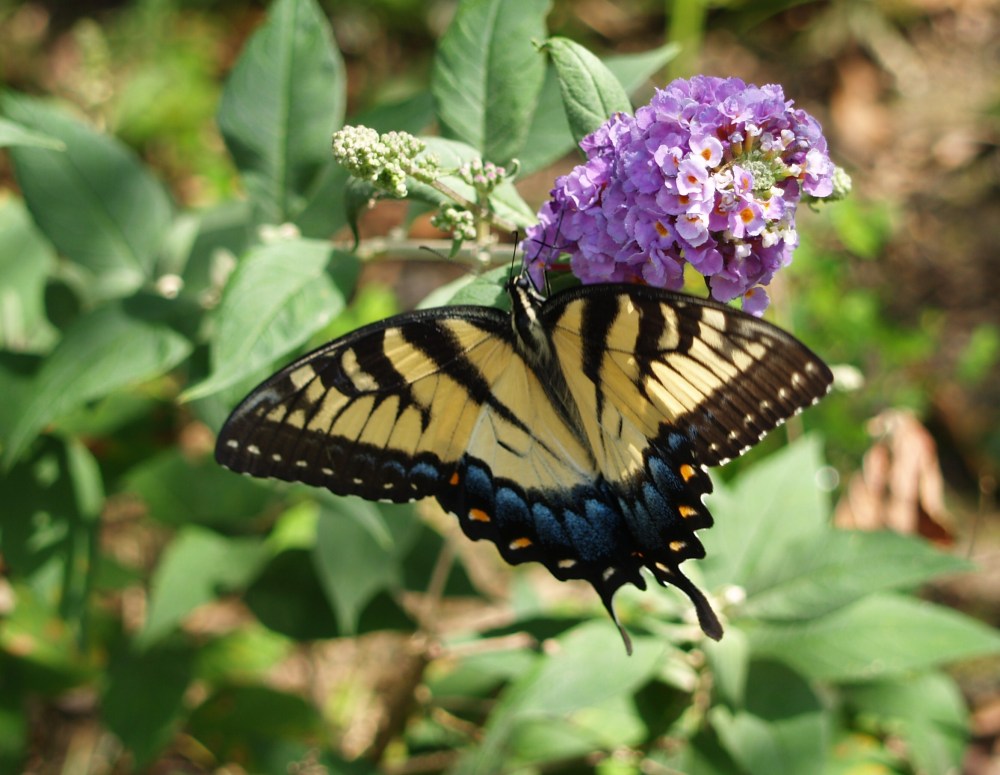 I don’t claim knowledge to distinguish between one bee or wasp and another, any butterfly or moth besides the ubiquitous Tiger swallowtail, or even frogs and toads. Toads, I can identify by sound I suppose, and I’m quite certain that the high pitched, agitated squeals I hear today as I walk along the paths that border the garden’s ponds are frogs of some sort. I know that there are a variety of frogs in the garden because the tunes they sing change regularly. For weeks, the many thousands of spring peepers make such a racket that sleeping can be a challenge, then this turns to more isolated chirps in varying tones.
I don’t claim knowledge to distinguish between one bee or wasp and another, any butterfly or moth besides the ubiquitous Tiger swallowtail, or even frogs and toads. Toads, I can identify by sound I suppose, and I’m quite certain that the high pitched, agitated squeals I hear today as I walk along the paths that border the garden’s ponds are frogs of some sort. I know that there are a variety of frogs in the garden because the tunes they sing change regularly. For weeks, the many thousands of spring peepers make such a racket that sleeping can be a challenge, then this turns to more isolated chirps in varying tones.  It’s difficult to begin to calculate the number of frogs that reside along and in each of the garden’s five ponds. Dozens leap to safety as I walk near, but surely others must be hunkered beneath overhanging shrubs, hostas, and Forest grass. Garden maintenance is occasionally delayed when every other step must be watched to avoid a tiny frog, and mowing the small sections of lawn is impossible on some days.
It’s difficult to begin to calculate the number of frogs that reside along and in each of the garden’s five ponds. Dozens leap to safety as I walk near, but surely others must be hunkered beneath overhanging shrubs, hostas, and Forest grass. Garden maintenance is occasionally delayed when every other step must be watched to avoid a tiny frog, and mowing the small sections of lawn is impossible on some days.
There are, I suppose, innumerable creatures living in and surrounding the ponds. The primary attraction of course, is the water, but many are drawn by the presence of the others. The food chain begins with tiniest bits of algae, then progresses to the variety of insects that float and hover over the ponds. While mosquitoes are unlikely to breed in any numbers in the moving water, there are plenty of potential breeding grounds in the vicinity, and my wife must slather on a variety of potions before going out. But, beside the large koi pond, dragonflies assure that mosquitoes are kept under control. They zip across and back, often chasing each other in territorial squabbles, but diving and snaring mosquitoes and other tiny insects, I figure. I have no doubt they are well fed.
In recent days I’ve noticed tiny fish in the koi pond, though the water has been murkier than usual due to heavy thunderstorms. In their early days, young fish keep to the edges of the pond where they feed on the short filaments of algae that cling to rocks. I suppose there might be some protection from predators here also, though this seems to make the small fish easier targets for the five foot water snake that now seems to be a permanent resident. The snake is becoming more bold in my presence, and now I’m cautious to check between boulders before reaching down into the pond. I’m certain that the snake is not poisonous, but I don’t wish to provoke a confrontation that might injure one of us or the other.
It is impossible to determine the number of koi in the pond. An inventory is difficult since they are constantly in motion, and after the number passed fifty several years ago I gave up any hope of counting them. The koi pond is over a thousand square feet, so the only time they are not scattered across the pond is when they gather to be fed. Then, their frantic movements make counting doubly difficult, so I’ll just suppose there are seventy-five to a hundred. Without a head count I cannot know whether the heron that visits regularly, or the hawks that circle overhead are successful in fishing the pond. When I had fish in the shallower, smaller ponds the heron nearly cleaned them out, but the large koi pond varies up to five feet deep, so this makes the heron’s task more difficult. In any case, there are enough koi now that if the heron is able to capture a few I’m not too concerned about it. When the bird has been around the koi stay low in the water, so they’re certainly bothered by its presence even if I’m not.
Without a head count I cannot know whether the heron that visits regularly, or the hawks that circle overhead are successful in fishing the pond. When I had fish in the shallower, smaller ponds the heron nearly cleaned them out, but the large koi pond varies up to five feet deep, so this makes the heron’s task more difficult. In any case, there are enough koi now that if the heron is able to capture a few I’m not too concerned about it. When the bird has been around the koi stay low in the water, so they’re certainly bothered by its presence even if I’m not.
